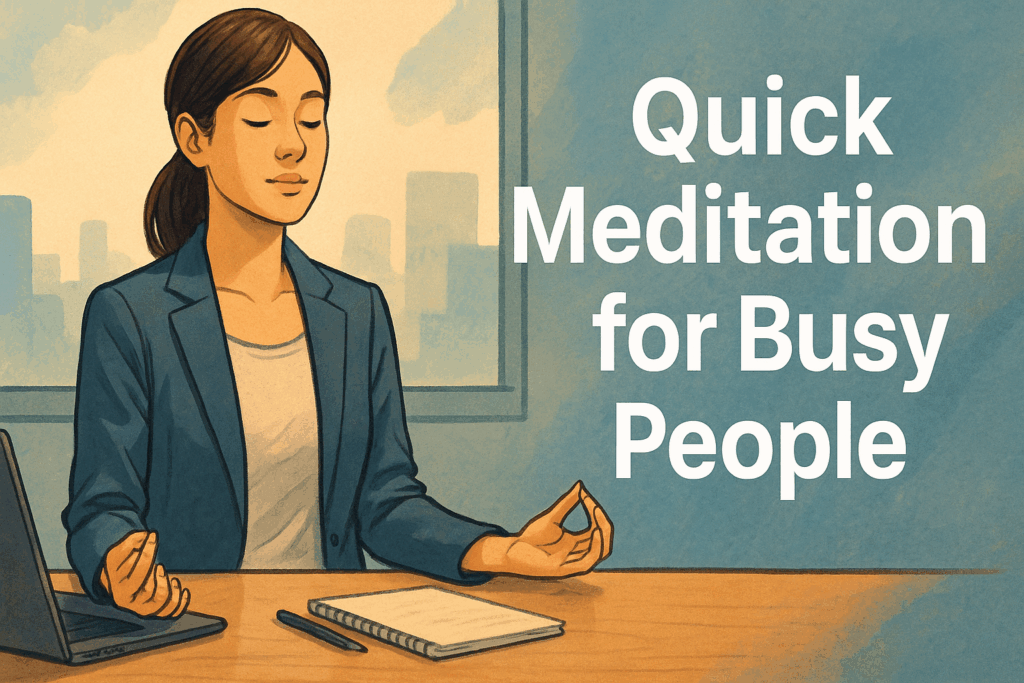
Quick meditation for busy people is more than just a mental pause—it’s a proven tool for emotional recovery and sharper focus, even in the most hectic lives.
Recent neuroscience, including findings from The Secret of Micro-Meditations for Busy Minds, shows that meditating for just one to three minutes can significantly reduce stress, improve mood, and enhance decision-making. These micro-meditations activate the brain’s regulatory systems without requiring a long session or perfect conditions.
If you’re like Eric, a purpose-driven social worker balancing service and self-care, you may long for inner stillness but feel trapped by time. The good news? You don’t need 20 minutes on a cushion. With a few focused breaths or a guided phrase, calm becomes accessible—anywhere, anytime.
This article explores how micro-meditation works, where to use it throughout your day, and why it might be the most practical form of mindfulness for the modern world.
Why Quick Meditation Works for Busy People

🧠 The Science Behind Quick Meditation
Quick meditation works because it taps into your brain’s natural ability to reset itself—even in less than 3 minutes.
Unlike traditional long-form meditation, micro-meditation activates the parasympathetic nervous system quickly, promoting relaxation and clarity without needing complete silence or a dedicated space.
A 2021 study referenced in The Secret of Micro-Meditations for Busy Minds found that just 60 seconds of mindful breathing can improve emotional stability and boost working memory. This is because even short bursts of focused awareness reduce cortisol levels and increase activity in the prefrontal cortex—your brain’s decision-making center.
For instance, taking a mindful pause between tasks—like inhaling deeply for four seconds and exhaling for six—can instantly decrease anxiety and increase task focus. It’s not about time spent; it’s about intention and presence.
That’s why busy professionals, like Eric, benefit most from quick, deliberate resets throughout the day—it fits their lifestyle without disrupting it.
🧭 Common Challenges for Busy People
Even when we know meditation helps, fitting it into a busy schedule can feel impossible.
Many people believe that meditation requires a quiet space, a lot of time, and perfect focus. For those juggling work, family, or daily stress, that feels unrealistic.
Eric, a 31-year-old social worker, often starts his day at 7 a.m. and doesn’t stop moving until late at night. He used to think meditation was only for monks or yoga enthusiasts—but he later realized that short, flexible practices work even better for his demanding lifestyle.
Common obstacles include:
- Lack of time: Long sessions feel overwhelming.
- Distractions: Constant phone pings and background noise.
- Mental fatigue: It’s hard to calm your mind after a chaotic day.
- Guilt: Feeling like you’re “doing it wrong” if your mind wanders.
The good news? Micro-meditations are designed to bypass these barriers. They require no special environment, and they actually work better when life gets loud—because that’s when your mind needs them most.
🔗 The Secret of Micro-Meditations for Busy Minds – Brainmindia Clinic
🧘♀️ How to Practice Quick Meditation Anywhere

🔧 Setting Up Your Space in Seconds
One of the best parts of quick meditation is that you don’t need a quiet room, candles, or even a yoga mat. It’s about presence, not perfection.
Here’s how to create a meditation-ready space—wherever you are:
- At your desk: Sit upright, put both feet on the floor, and rest your hands on your lap.
- In the car (parked): Take a deep breath, unclench your jaw, and rest your hands on the steering wheel.
- In a crowded room: Close your eyes for 30 seconds, or simply lower your gaze and focus on your breath.
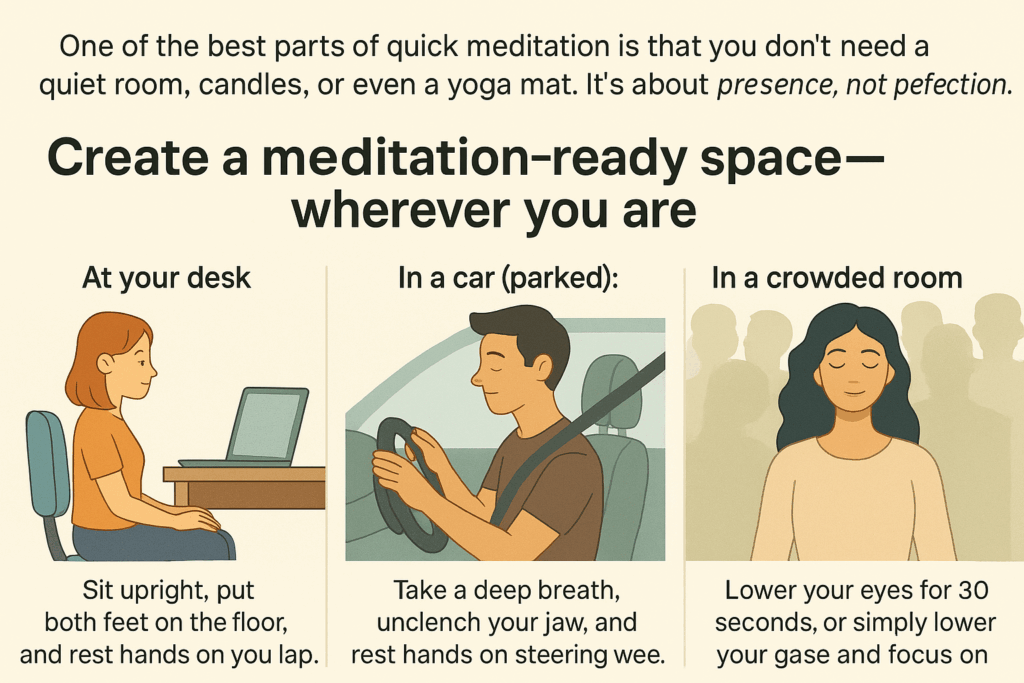
Even 10 seconds of stillness can reset your mood and energy levels. According to The Secret of Micro-Meditations for Busy Minds, quick breathing exercises and sensory check-ins can rewire the brain for calm—even in noisy environments.
⏱️ Simple 3-Minute Meditation Steps
If you’ve got three minutes, you’ve got space for transformation. Here’s a basic routine:
- Minute 1 – Ground yourself:
Take slow breaths. Inhale for 4 counts, hold for 4, exhale for 4. Repeat. - Minute 2 – Check in:
Ask yourself, “What am I feeling right now?” Don’t judge—just notice. - Minute 3 – Visualize calm:
Picture a peaceful place—like a lake or forest—and imagine breathing in that stillness.

This brief sequence, supported by neuroscience research from Brainmindia Clinic, helps reduce cortisol levels and increases focus, even with just one minute per step.
🔗 How to ‘Micro-Dose’ Meditation for Maximum Productivity – Inc.com
🧩 Micro-Meditation Techniques for a Busy Schedule

💻 Desk Meditation at Work
Even during a hectic workday, micro-meditation can fit into 60 seconds or less. According to Brainmindia Clinic, brief mindfulness techniques at your desk improve emotional regulation and sharpen decision-making.
Here’s how to try it:
- 1-minute breathing reset:
Close your eyes (or soften your gaze). Inhale deeply for 4 seconds, hold for 4, exhale for 6. Repeat for one minute. - Gratitude flash:
Pause and silently name one thing you’re grateful for—your morning coffee, a kind email, or simply your breath. - Tactile awareness:
Gently touch your fingertips together, focusing on the sensation. This grounds your awareness in the present.

These practices don’t interrupt your workflow—they refresh your mind in the middle of it.
🚌 On-the-Go Mindfulness Practices
Running errands, commuting, or waiting in line? You can still meditate.
- Transit breathing:
On a train or bus, follow your breath with quiet attention. Let the sounds around you become background noise—not distractions, but part of your mindfulness. - Sensory check-in:
Ask yourself:
What do I see? Hear? Smell? Feel? Taste?
This technique reconnects your brain with the present moment. - Walking meditation (30 seconds):
Feel the contact between your feet and the ground. Walk slowly, syncing your steps with your breath.
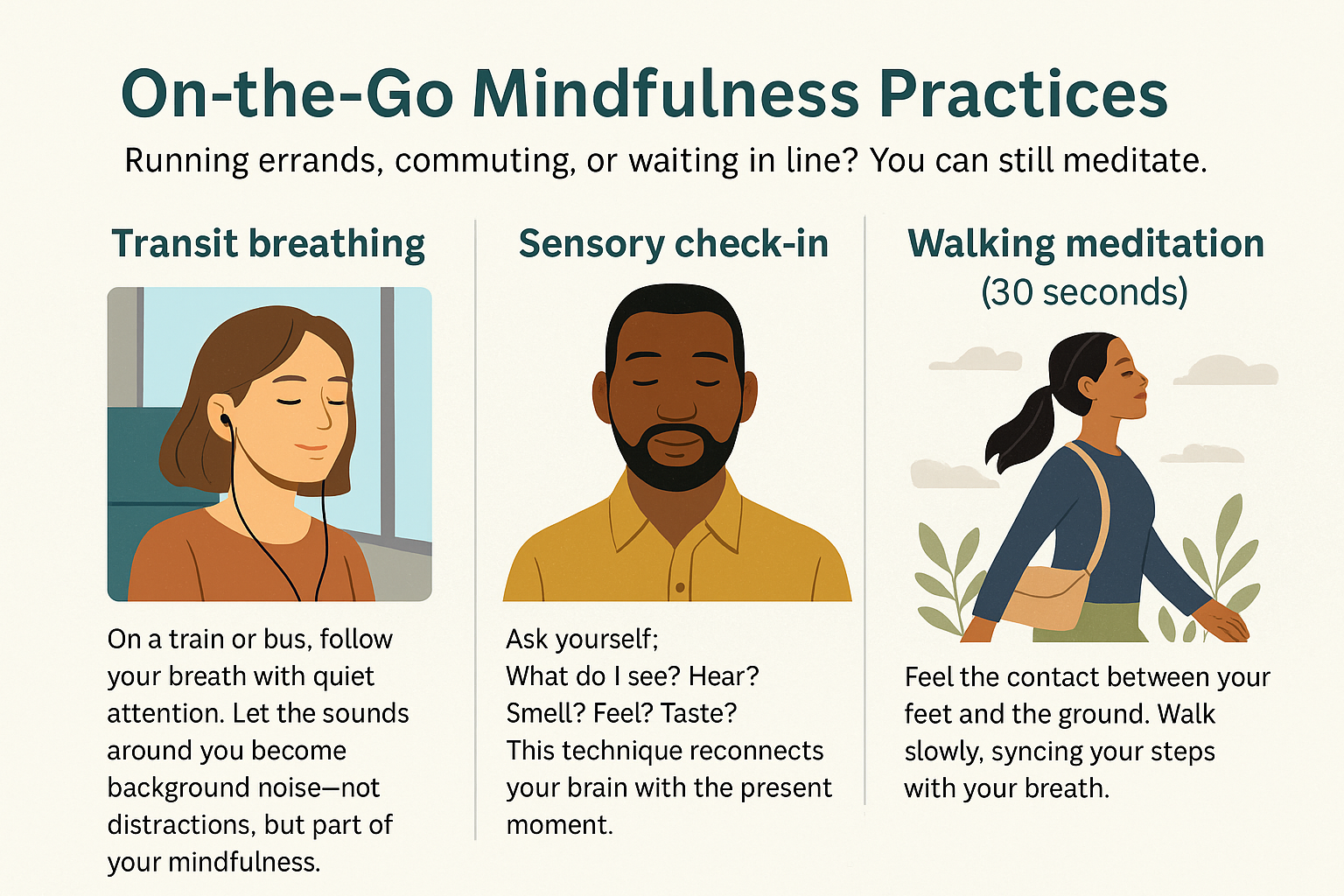
These portable practices are supported by findings in cognitive neuroscience, showing that even 20-second meditations can improve mood and reduce stress markers.
🔗 Micro meditation: the 60-second reset for busy minds – Happiest Health
🌟 Top Benefits of Quick Meditation
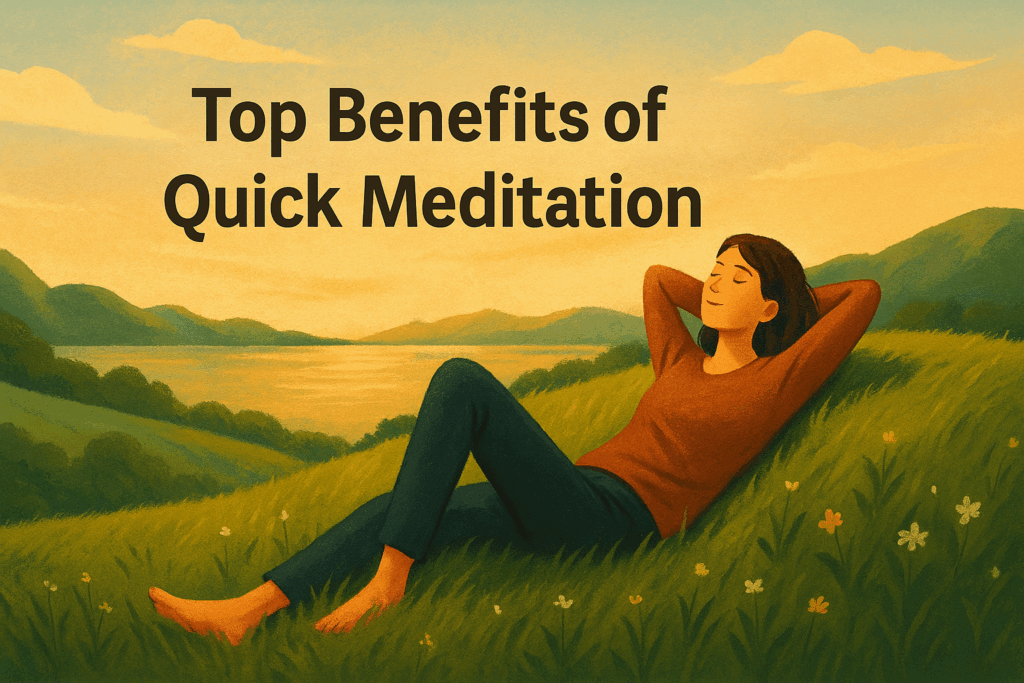
🧘♂️ Stress Relief in Minutes
Quick meditation can significantly reduce stress—even in just 60 seconds.
A 2021 study cited in Brainmindia Clinic found that micro-meditations help lower cortisol levels, the hormone responsible for stress. Participants who practiced brief mindfulness throughout the day reported feeling calmer and more in control of their emotions.
Unlike traditional long-form sessions, these micro-moments work in real time, allowing busy individuals to manage rising stress before it overwhelms them.
Even a 30-second mindful breath during a difficult meeting or a short pause between tasks can reset your nervous system.
🎯 Boosting Focus and Productivity
In addition to calming the mind, quick meditation enhances cognitive function. Neuroscience research confirms that short bouts of mindfulness improve attention span, memory recall, and decision-making speed.
Here’s why it works:
- Reduces cognitive overload by giving the brain micro-breaks.
- Enhances mental clarity by shifting focus inward, even briefly.
- Increases resilience, helping you bounce back faster from interruptions or frustrations.
Incorporating just a few 1–3 minute meditations into your workday can result in measurable improvements in performance and focus.
🔗 Neuroscience of Mindfulness Meditation – Wharton Neuroscience
🔁 Tips to Make Quick Meditation a Daily Habit

⏰ Finding the Best Time in Your Day
The secret to making quick meditation stick? Link it to something you already do.
For example:
- Right after brushing your teeth
- Just before opening your email
- While waiting for your coffee to brew
By tying your meditation to an existing habit, you remove the need for willpower or extra planning. These micro-habits stack easily into your daily rhythm without disrupting your schedule.
Even 10 seconds of mindful breathing after checking your phone can begin to reshape your mental patterns.
🔔 Using Reminders and Apps
If you’re just starting out, using reminders and apps can help you build consistency.
Popular apps like Headspace, Calm, and Insight Timer now offer short-format meditations tailored for busy people.
You can also:
- Set calendar alerts labeled “Pause to Breathe”
- Place sticky notes on your workspace with affirmations
- Use smartwatches to prompt a 1-minute check-in
The key is to lower the barrier to entry. With time, these brief pauses become part of who you are—offering mental clarity, peace, and resilience every day.
🔗 The 4 Best Meditation Apps of 2025 – NYT Wirecutter
🧘♀️ Conclusion: Calm is Just a Minute Away
Quick Meditation for Busy People isn’t just a trend—it’s a science-backed habit that brings calm, focus, and emotional balance within minutes.
Whether you’re overwhelmed at work or juggling tasks at home, taking just 60 to 180 seconds to pause and breathe can shift your entire mindset.
As highlighted in the Brainmindia study, even a single minute of mindful breathing can improve mood and cognitive function.
The beauty lies in its simplicity. No need for silence, incense, or perfect posture—just your breath and a moment of intention.
So, the next time you feel stress rising, remember:
You don’t need more time. You just need a moment.
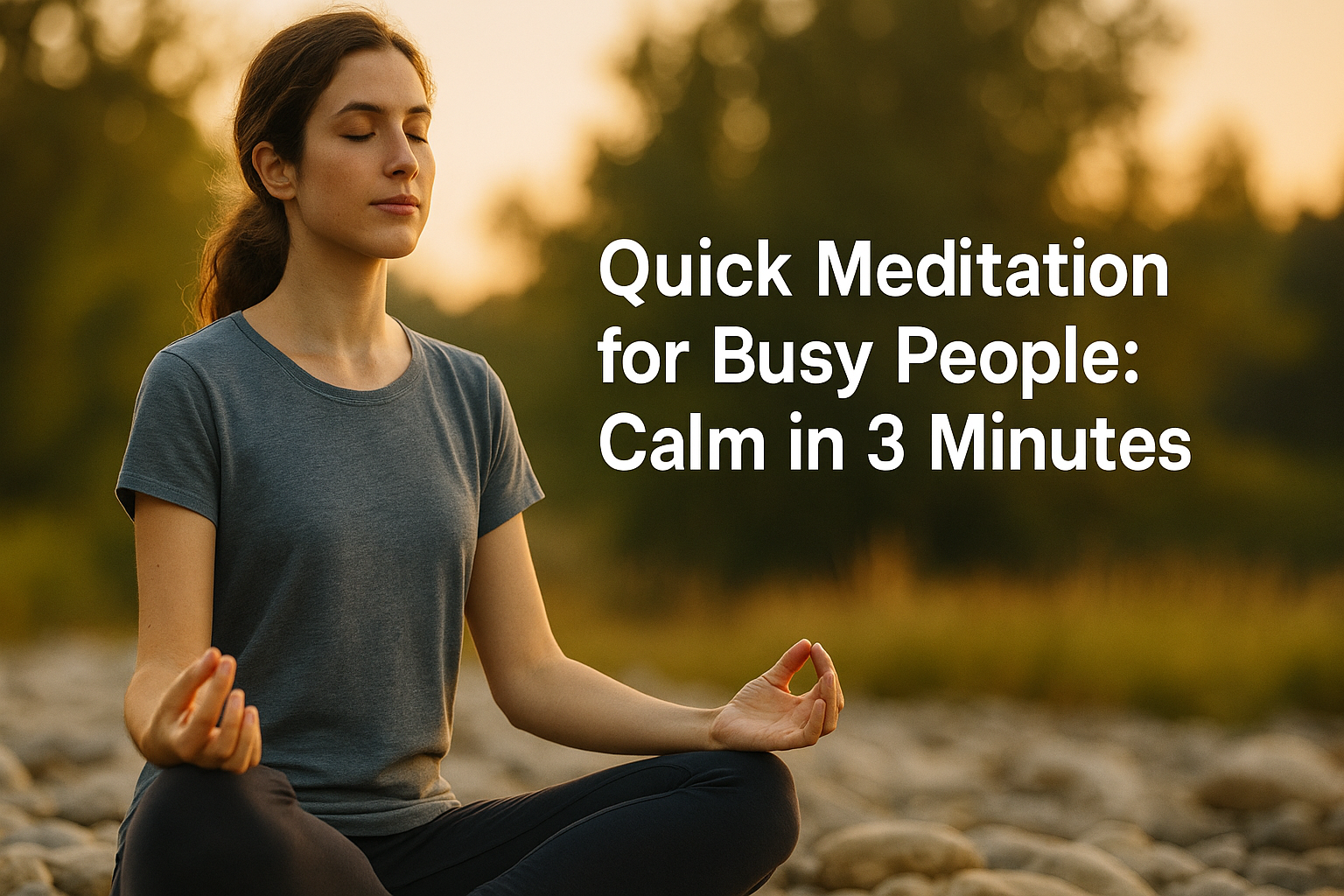
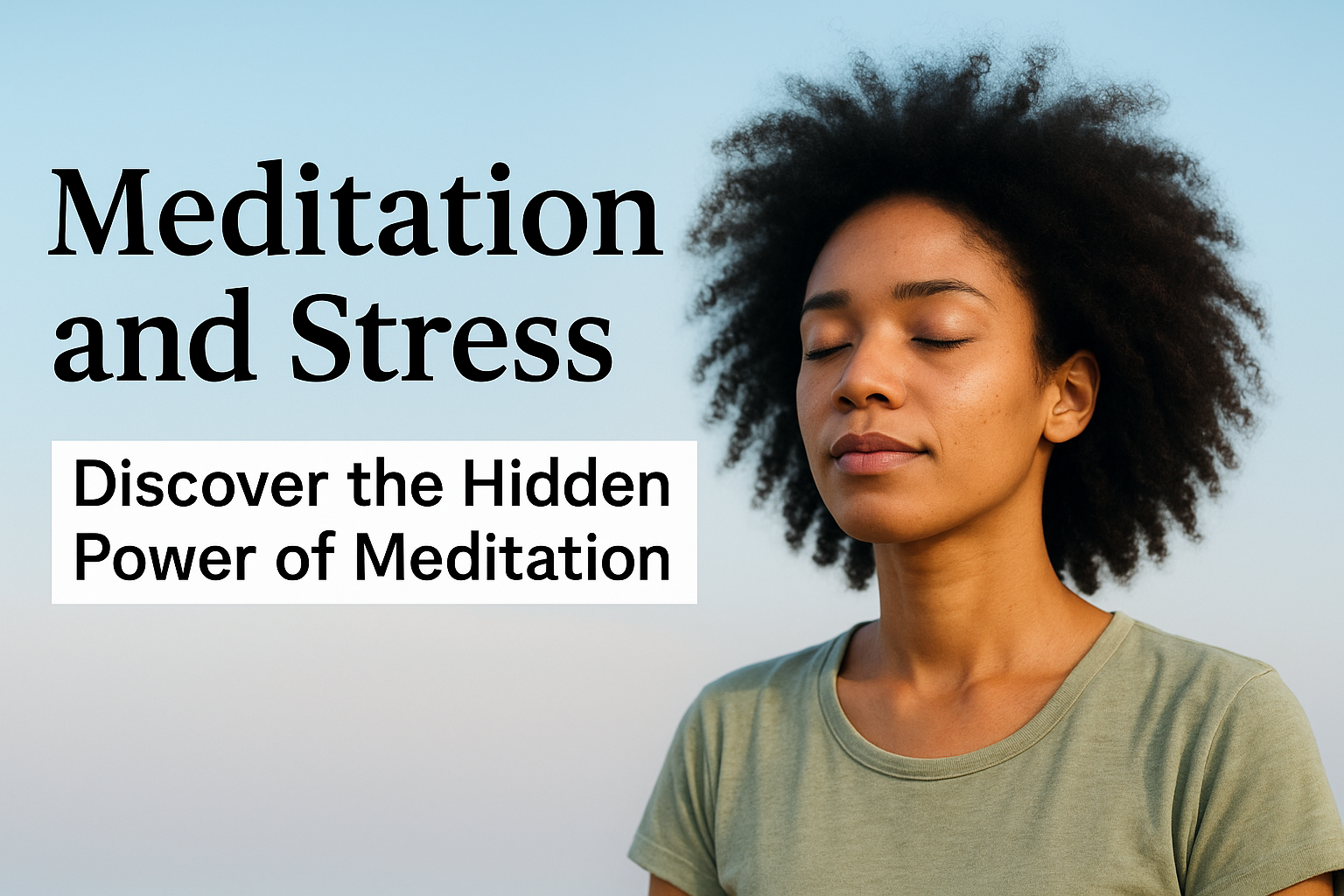


Comments